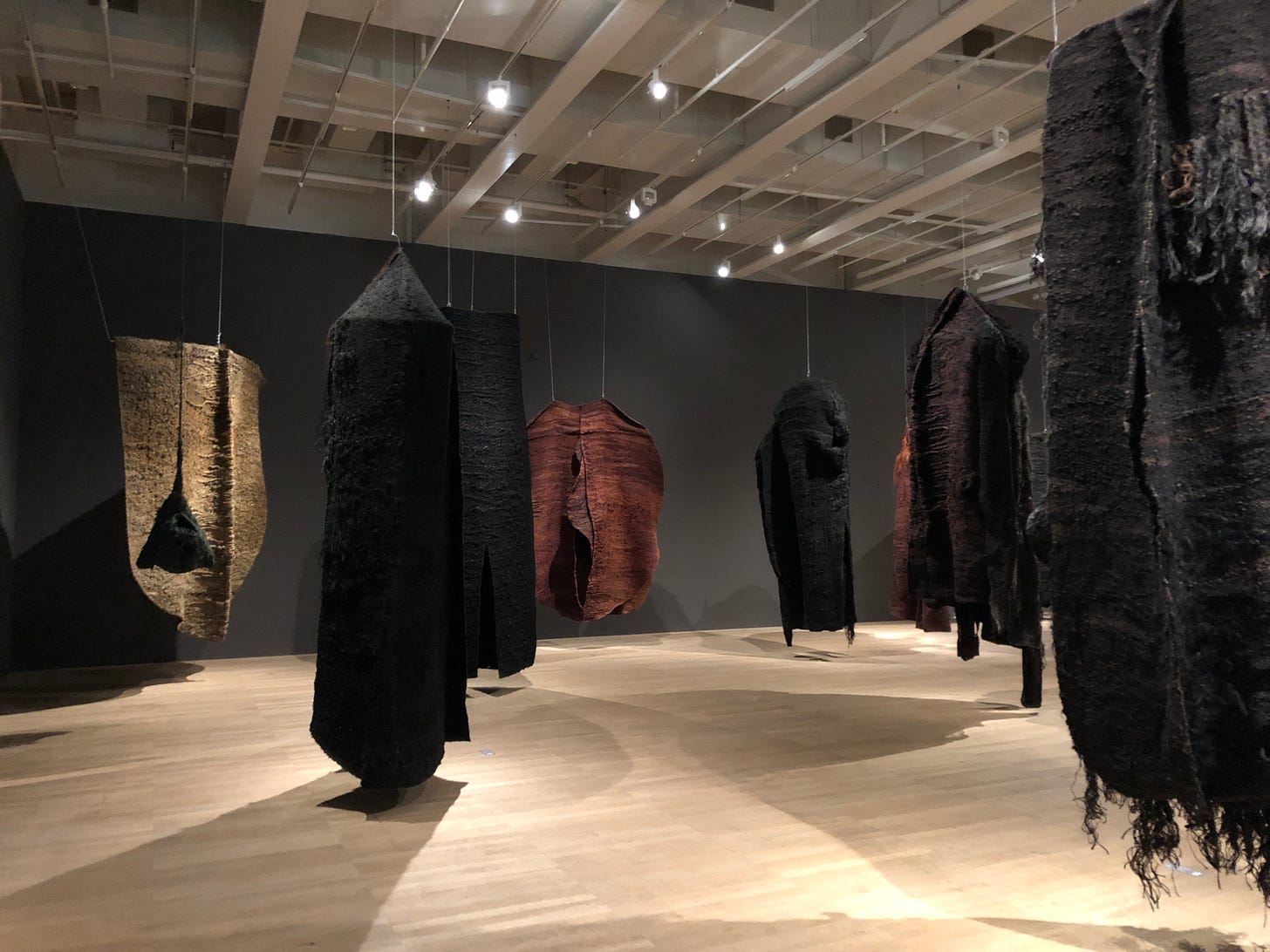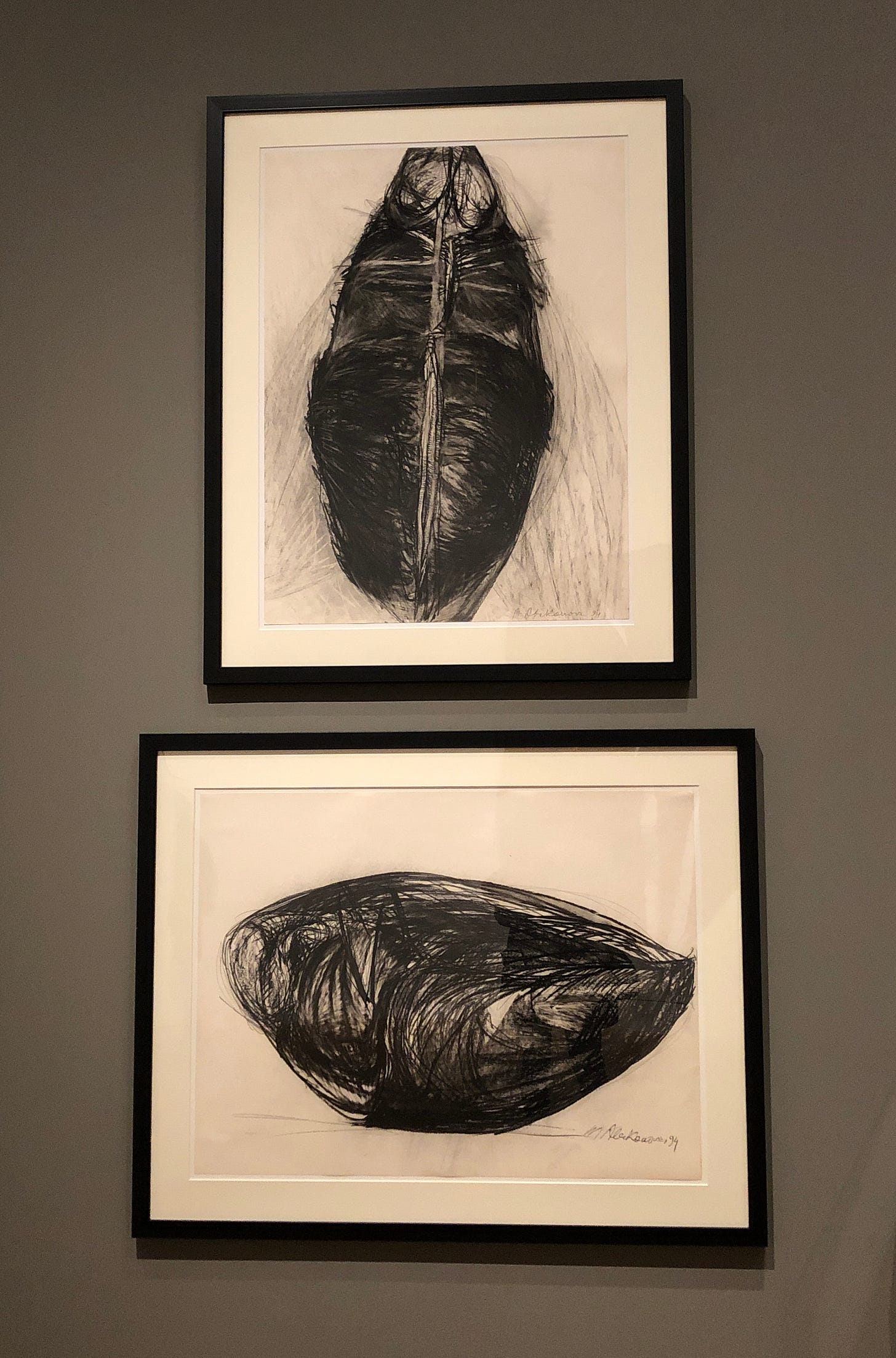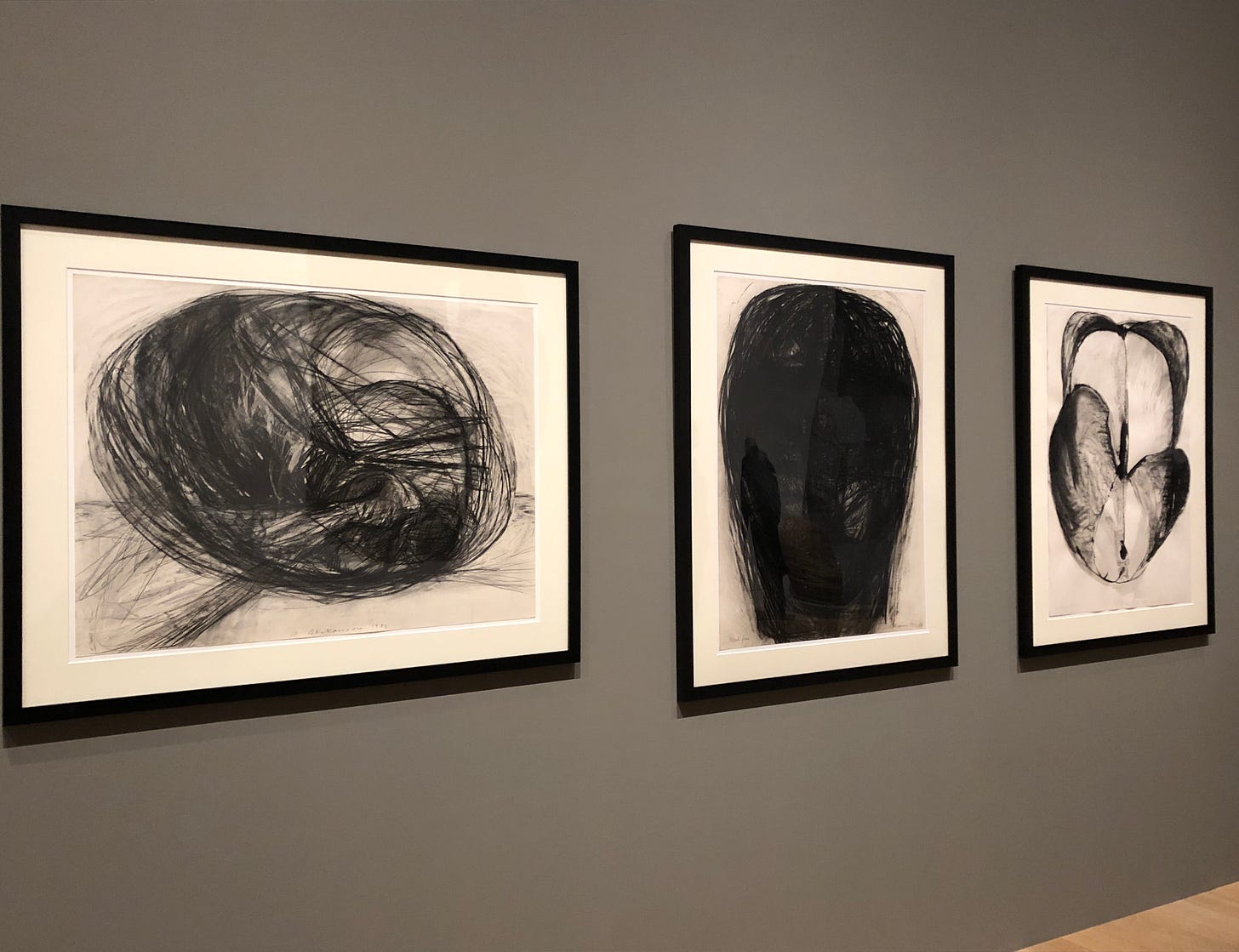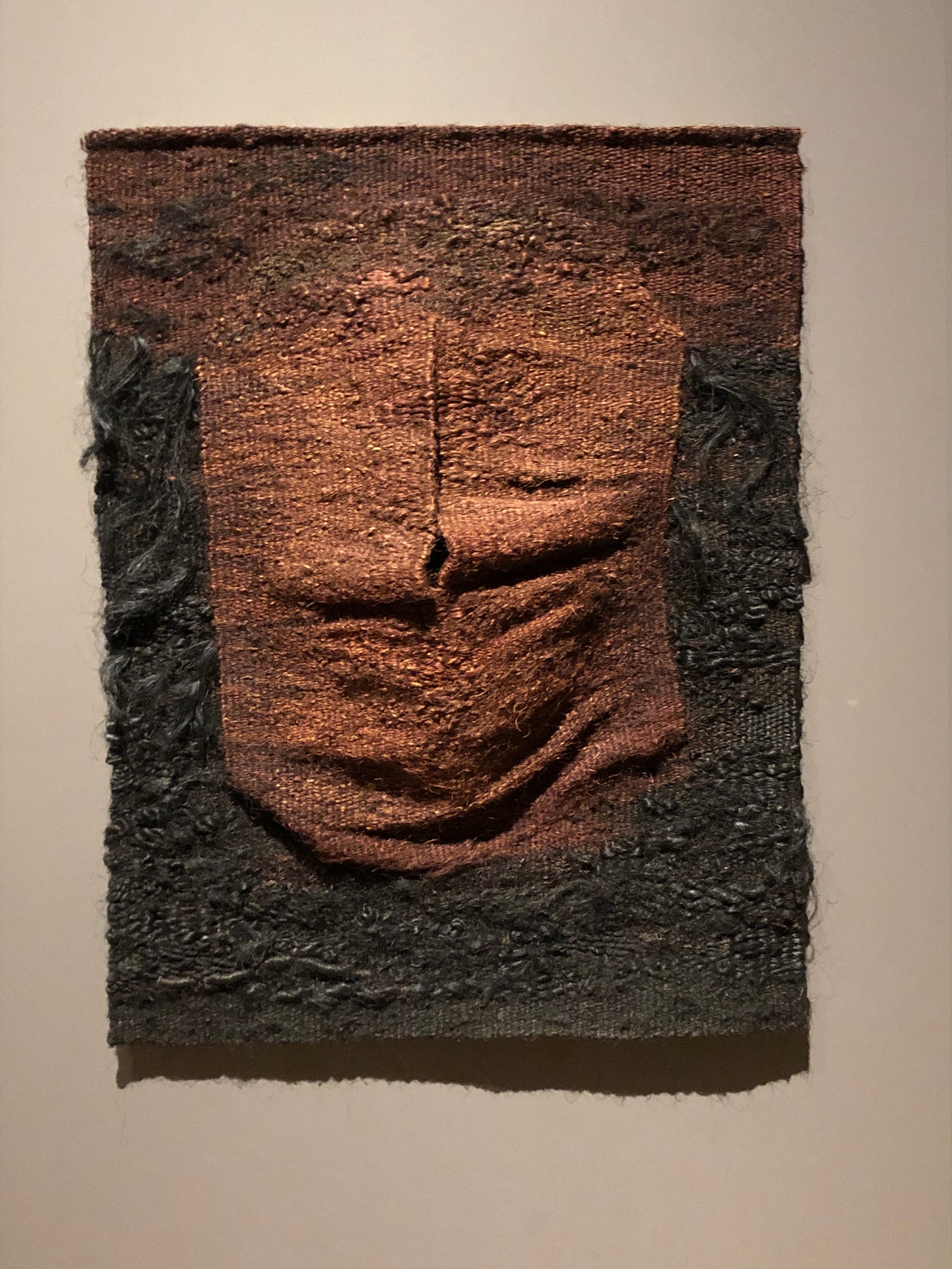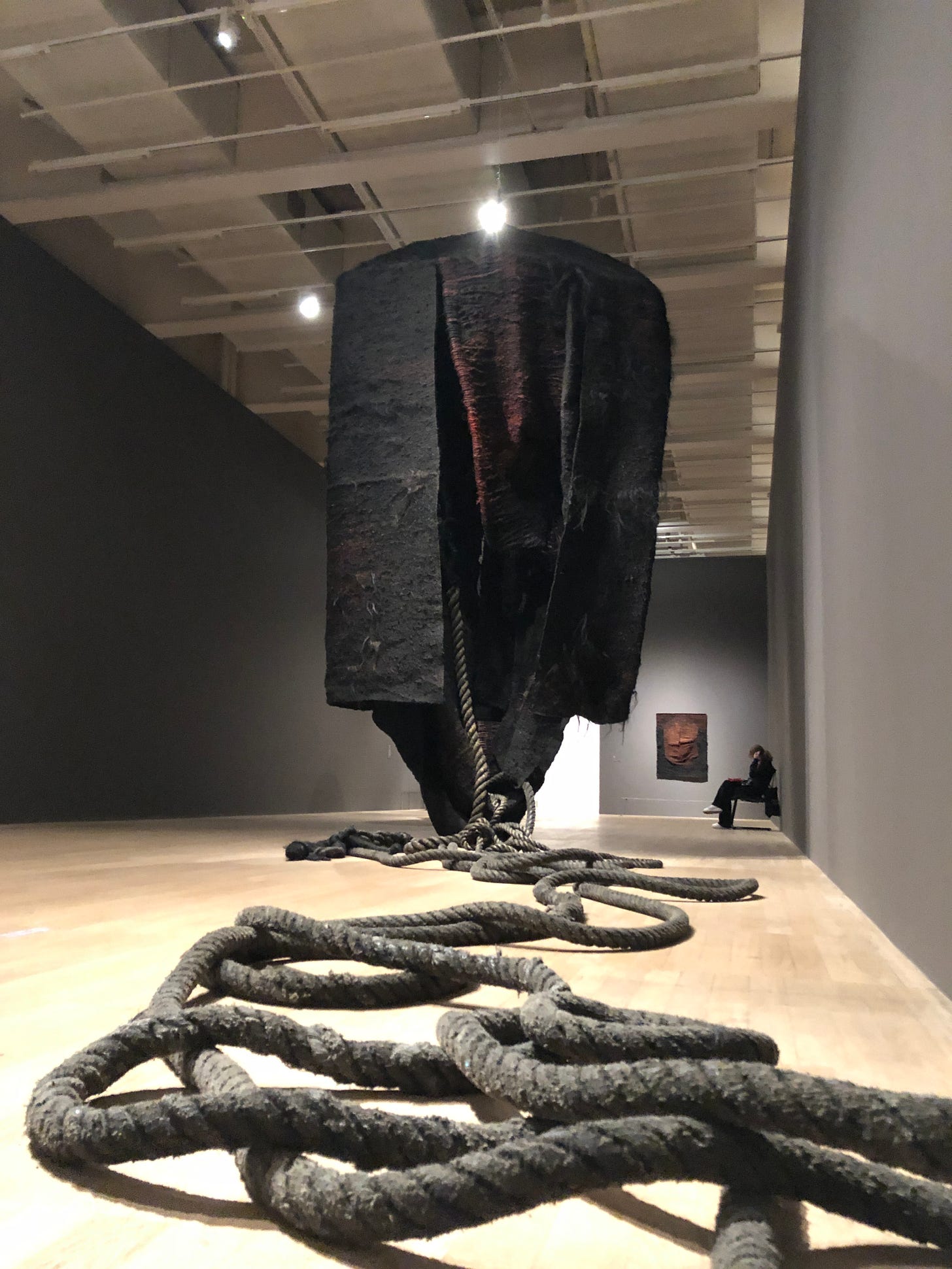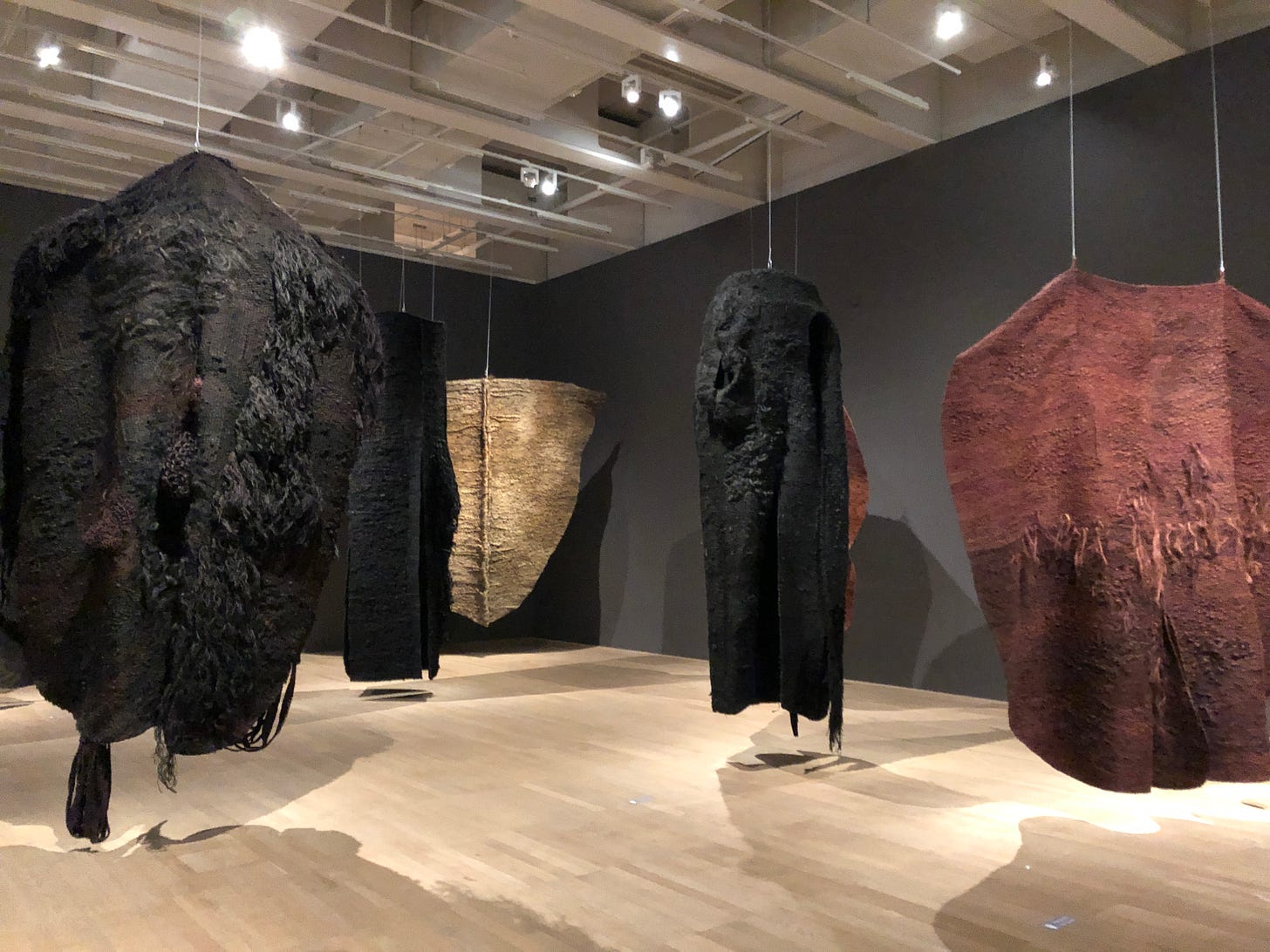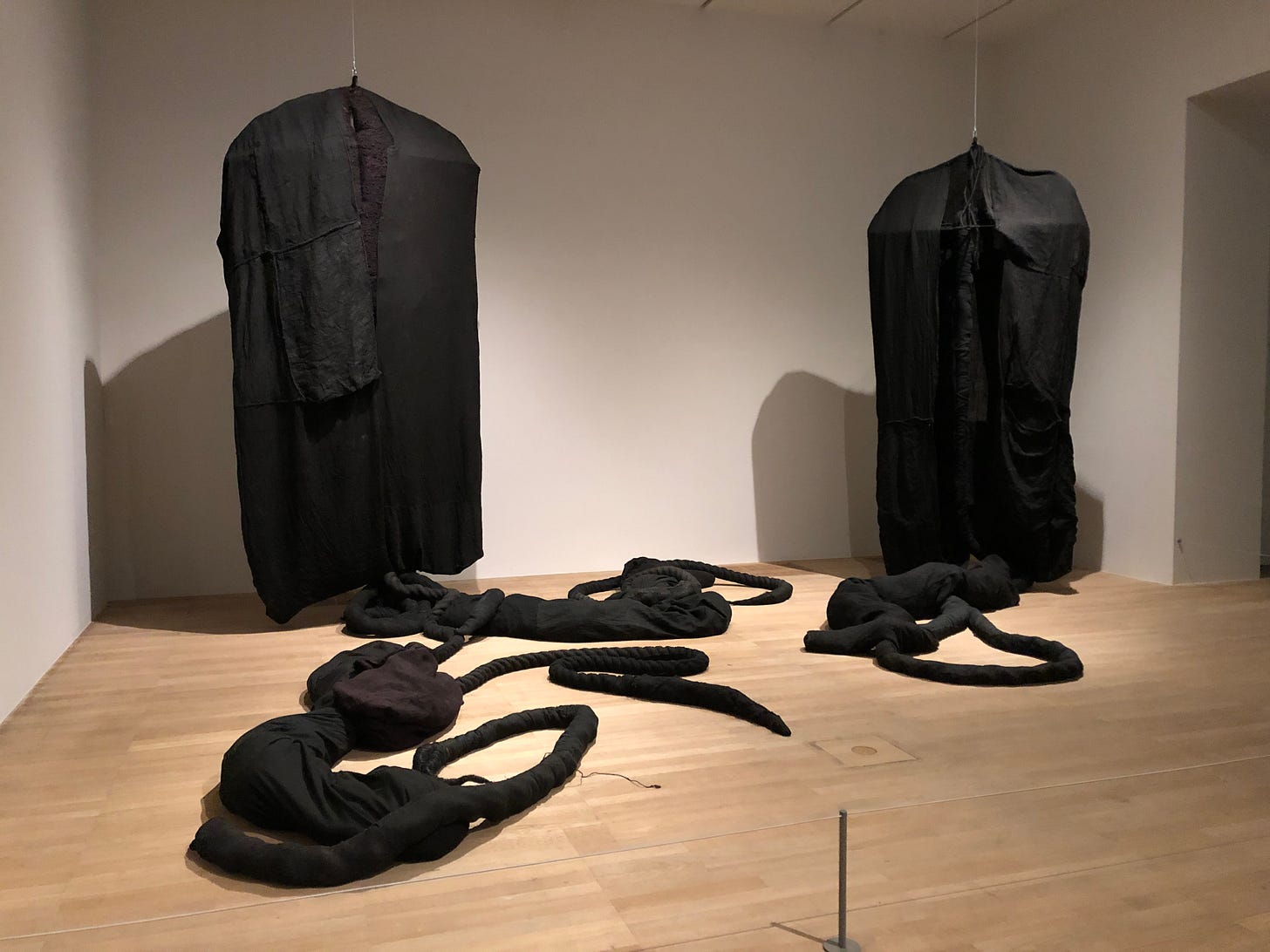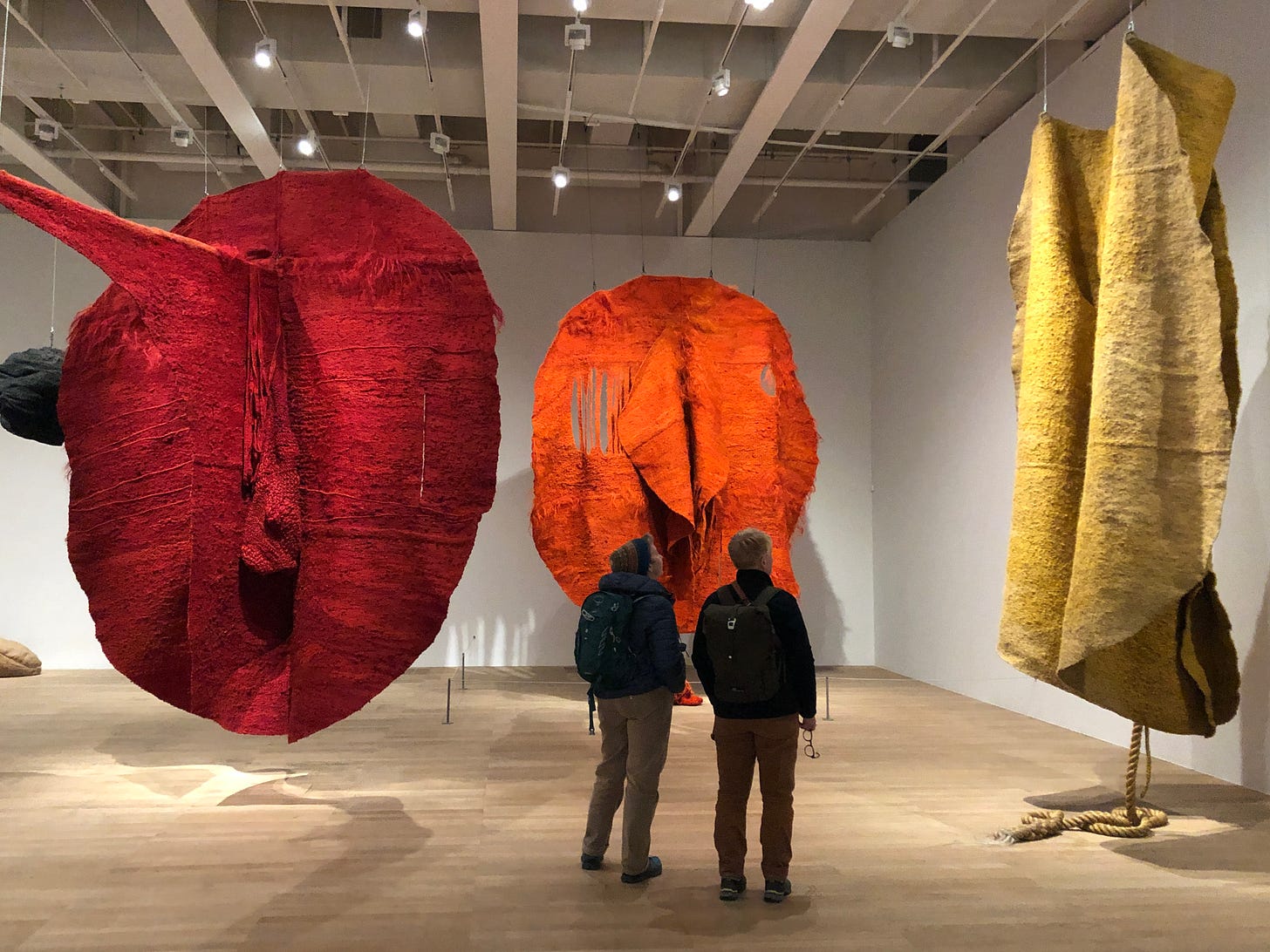Magdalena Abakanowicz, Tate Modern, London, UK
Thoughts on Magdalena Abakanowicz's exhibition, Every Tangle of Thread and Rope
Magdalena Abakanowicz, Installation of Abakans at Tate Modern
Last week, I visited the Magdalena Abakanowicz exhibition which is currently on display at Tate Modern, London. I had not heard of this artist before seeing incredible photographs on social media of people walking around the ‘Fibrous Forest’ installation. In person, the works are huge in scale and their presence is overpowering. A trip to visit this exhibition is essential to learn about this important female artist.
The exhibition follows Tate’s custom style of presenting a chronological journey of the artist’s career, identified in the accompanying exhibition guide as a survey of the ‘transformative period of the artist’s early career when her weavings came off the wall into three-dimensional space.’ When learning about an artist for the first time this is a successful display, as the visitor gets to witness the thoughts and influences that lead the artist to changes and developments in their work.
The organic forms created by Abakanowicz in her early works appear to evolve and mingle with the trauma of childhood memories and having lived through the Second World War. The experience of severed limbs and horrors. I dislike unnecessary biographical interpretations of artist’s work, which is significantly overused in relation to women artists, but this work is clearly marked by a very personal trauma and imagination. The product of a haunted mind.
Magdalena Abakanowicz, From the Cycle Flies, 1994
Charcoal drawings from the cycle ‘Flies’ 1994, look like cocoons or pupas, dark forms protecting something deep within. Equally they could be foetuses growing slowly within their sacks. These protective homes become ominous through hastily drawn lines and repetitive dark black markings. Is life protected here? The shadowy objects could equally represent the troubled and diseased brain, or nature slowly dying.
Abakanowicz’s works have such a darkness. To me, the dark forms are like apparitions from nightmares, evolved from childhood terrors. Dark clouds hover indefinitely. Organic monsters lurk in the forest. I was fascinated by a quote from the artist included in the wall text, ‘Strange powers dwelled in the woods and the lakes that belonged to my parents. Apparitions and inexplicable forces had their laws and their spaces…’ Abakanowicz’s deep interest in the inexplicable forces of nature appears to merge with the equally overpowering explicable force of man and war. Nature and man are linked and interlinked and I felt that all the works that followed in the exhibition explored this.
Magdalena Abakanowicz, Pregnant, 1970-80
Before the display of the three-dimensional works, a lone piece entitled Pregnant is hung on the wall. The title of the work very clearly defines meaning, but when I looked at the work before reading the label, I immediately thought it resembled a vulva. Observing the work again with the title in my mind I could see this could represent either a swollen pregnant belly or female genitals, both instrumental in bringing life to the world. Whether this was a theme important to the artist or this strategically curated hang influenced my reception of the other works, I do not know, but I viewed the rest of the exhibition with this imagery at the forefront of my mind.
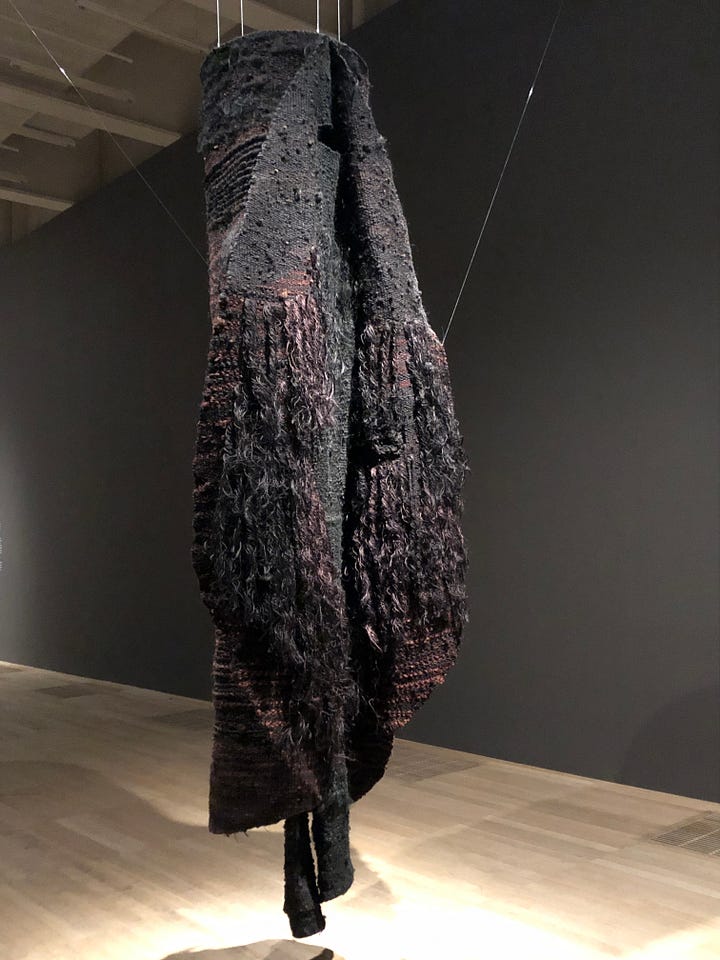
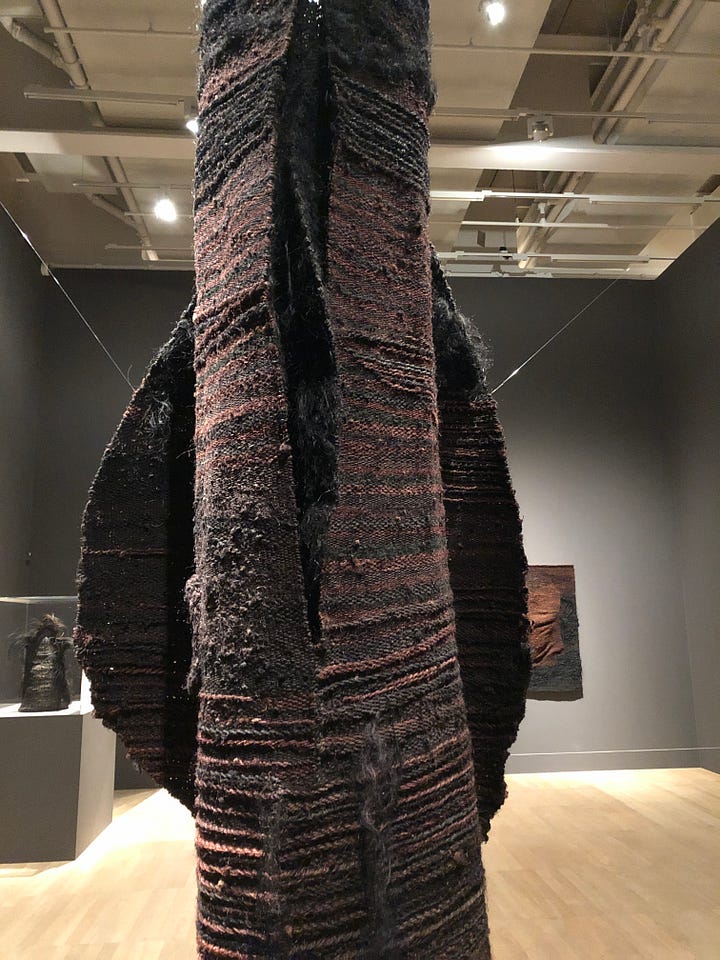
Magdalena Abakanowicz, Abakan étroit, 1967-8
To me, the three-dimensional works were all so vaginal. The first in the gallery that can be experienced from all angles is like a double vagina, a different vulva on each side. Larger than human size it made me feel like I could slip through the sculpture and be born into the world, and in reverse I could be born back into the earth.
Magdalena Abakanowicz, Abakan Situation Variable II, 1971
Abakan Situation Variable II, appears to follow the same theme, this time with long lengths of rope snaking their way from the bottom of the work across the floor of the gallery. Is this an umbilical cord or the roots of a tree? Nature, organic forms, human life, are all so inextricably linked.
Abakanowicz did not want to be known as a textile or fibre artist. This is understandable as this label was often associated with crafts, and the woven sculptures she created are anything but. The three-dimensional works are fascinating as they are made from organic materials, and are so monumental in size and structure, and so powerful in presence, that they defy the materials used. So pioneering were the works at the time of conception that they escaped categorisation and were coined ‘Abakans’ by an art critic who named them after the artist’s surname. Imagine creating such innovative works that they are named after you to achieve an accurate definition…? How fabulous.
Magdalena Abakanowicz, Installation of Abakans at Tate Modern
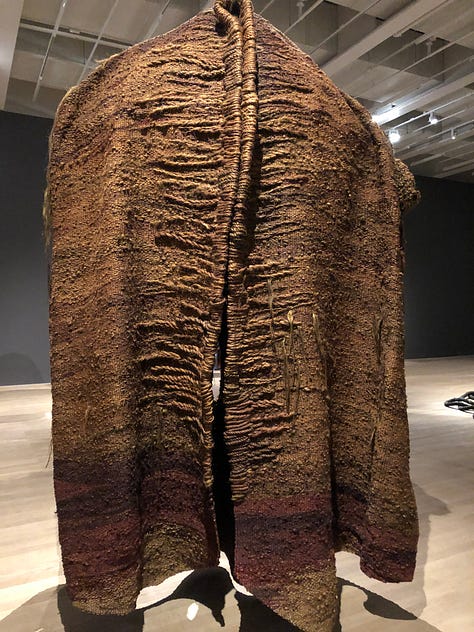
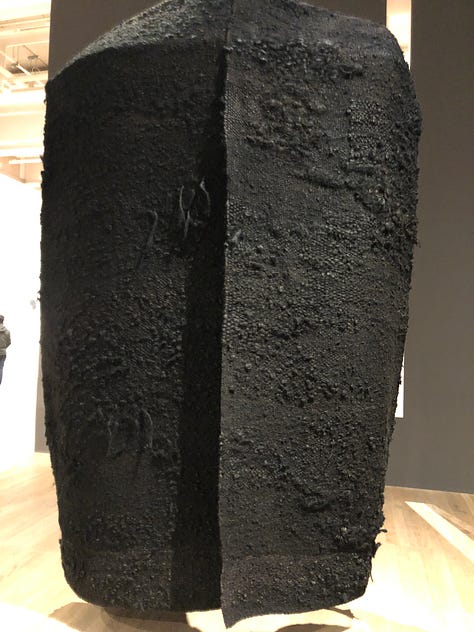
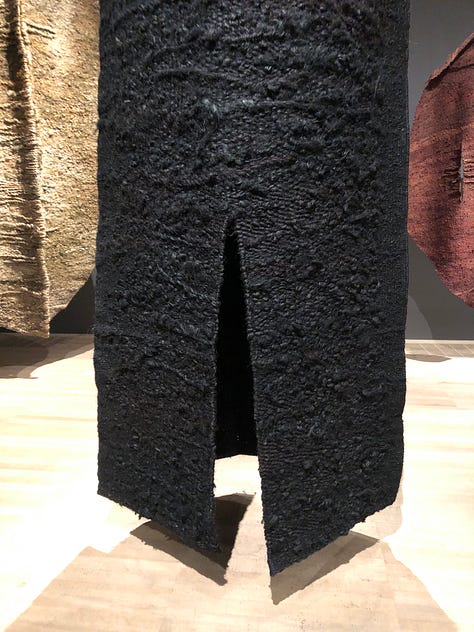
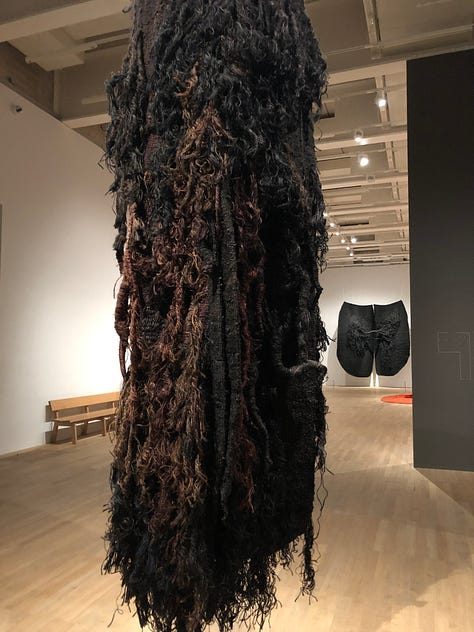
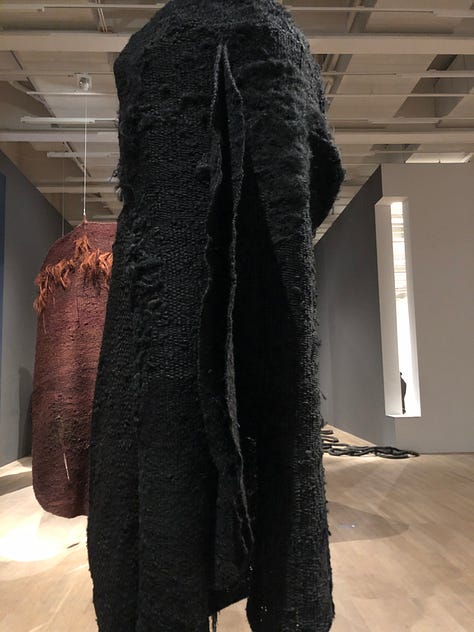
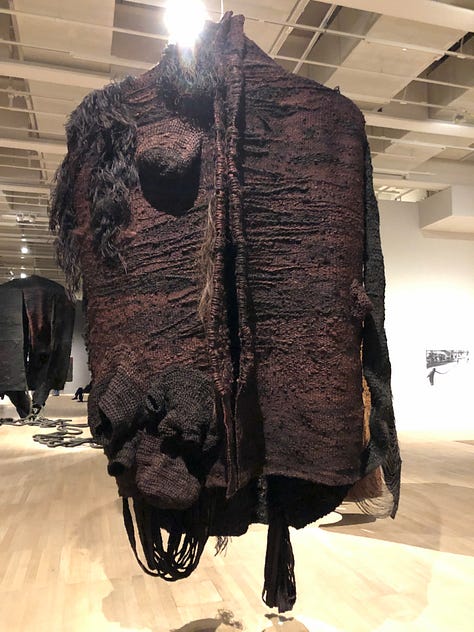
Magdalena Abakanowicz, Details of Abakans at Tate Modern
The forest of Abakans in the Tate Modern exhibition are grouped together to echo some of the artist’s own installations. For the artist, the forest provided shelter, and the clustering of works in the exhibition space created a dialogue with the gallery, which she referred to as ‘situations’ or ‘environments’. The installation immediately struck me as a forest of spirits. The sculptures hanging like great empty coats or the shadows of people long departed. On closer inspection the theme of female genitalia returned, each sculpture portraying a unique portrait of a vulva. The dark earthy tones seem to represent bark, earth, blood, and mud. The theme of nature, life, birth, and death, are present in this forest of trees, forest of human spirits, or forest of vaginas.
Magdalena Abakanowicz, Set of Black Organic Forms, 1974
The Set of Black Organic Forms are displayed in a ‘situation’ devised by the artist. The huge black works, with ropes spilling from the bottom look like long umbilical cords flowing out and desperately trying to reconnect with the earth. Alternatively, the huge forms could be seen as open torsos with bowels overflowing from open wounds. Whether this is Life or Death, the artist has exposed it for all to see.
Magdalena Abakanowicz, Installation of Abakans at Tate Modern
Enormous Abakans in yellow, red, and orange, to me, still appear to resemble intimate portraits of vulvas, while being suggestive of other body parts, organs, and anatomy.
Life in Abakanowicz’s works appears as an endless cycle of birth, existence, and returning to nature, which every tangle of thread and rope explores.
Magdalena Abakanowicz, Every Tangle of Thread and Rope is on display at Tate Modern, London, UK until 21 May 2023.
All photographs are my own.




